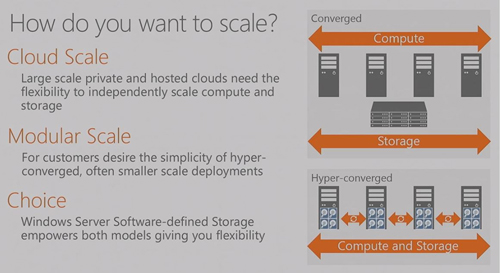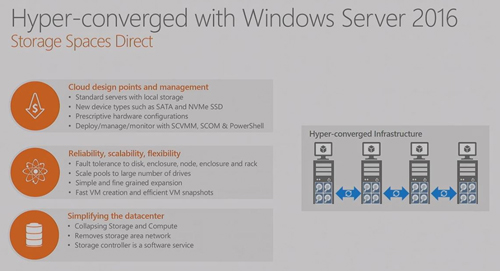News
Microsoft Adding Hyperconvergence Boost to Windows Server 2016
- By Kurt Mackie
- September 08, 2017
Microsoft is beginning to share some details about hyperconverged infrastructure (HCI) improvements coming to Windows Server 2016.
Most of these improvements will be showcased at the Microsoft Ignite conference, which starts on Sept. 25. However, Microsoft sketched out three of those improvements this week in an announcement. They'll be arriving with Windows Server 2016 version 1709, which is expected to be released as a current branch in September or October.
First, Microsoft expects to deliver increased efficiency with regard to data deduplication in HCI scenarios, namely "upwards of 95% data efficiency," according to the announcement.
Next, Microsoft is promising an "all new management experience" for Windows Server 2016 HCI scenarios, as well as improvements to "reduce the operational expenses." Those details weren't described.
Lastly, "persistent memory" silicon improvements will be coming, along with improved "erasure coding performance." Erasure coding breaks data into fragments and stores it across different locations. Persistent memory is typically described as providing faster data access on nonvolatile dual inline memory modules (NVDIMMs) because they have dynamic random access memory (DRAM) with a dedicated flash memory segment. Persistent memory hardware is helpful for use in computing environments that require "frequent access to large, complex data sets and environments that are sensitive to downtime caused by power failures or system crashes," according to Micron's description of the term.
And that's about it as far as Microsoft's bare bones sketch went regarding the coming HCI improvements.
By HCI for Windows Server 2016, Microsoft is referring to a specific network arrangement that combines compute and storage functions together in a cluster. Windows Server 2016 offers "converged" and "hyperconverged" options, according to a 2016 Ignite talk by Steven Ekren, a senior program manager on the Windows Server team, who showed this slide:
 [Click on image for larger view.] Converged vs. hyperconverged options for Windows Server 2016. (Source: 2016 Ignite session)
[Click on image for larger view.] Converged vs. hyperconverged options for Windows Server 2016. (Source: 2016 Ignite session)
Quite a lot of that HCI technology is associated with the use of the Storage Spaces Direct technology in Windows Server 2016. Storage Spaces Direct is "software-defined, shared nothing storage" technology that's likely cheaper and faster to use than relying on storage area network (SAN) devices, according to a summary offered last year by Microsoft Most Valuable Professional Aidan Finn.
Storage Spaces Direct promises the use of newer and lower cost storage devices, including "SATA, SSD and NVMe disk devices that were previously not possible with clustered Storage Spaces with shared disks," according to Microsoft's "What's New" document. Storage Spaces is the earlier software defined networking technology Microsoft released with Windows Server 2012.
Here are the benefits of using Storage Spaces Direct, according to Ekren's 2016 talk:
 [Click on image for larger view.] Benefits of Storage Spaces Direct in Windows Server 2016. (Source: 2016 Ignite session.)
[Click on image for larger view.] Benefits of Storage Spaces Direct in Windows Server 2016. (Source: 2016 Ignite session.)
One catch for IT pros excited by the coming HCI improvements is that Storage Spaces Direct requires using the Datacenter edition of Windows Server 2016. It's not part of the Standard edition.
Currently, there's a preview release of Windows Server 2016 (build 16278) available for testing. It includes support for "Storage Class Memory (SCM) in Spaces Direct" and support for "Cluster Sets" that "significantly increases hyper-converged SDDC [software defined data center] cloud scale by grouping multiple clusters into a larger fabric," according to an announcement.
About the Author
Kurt Mackie is senior news producer for 1105 Media's Converge360 group.